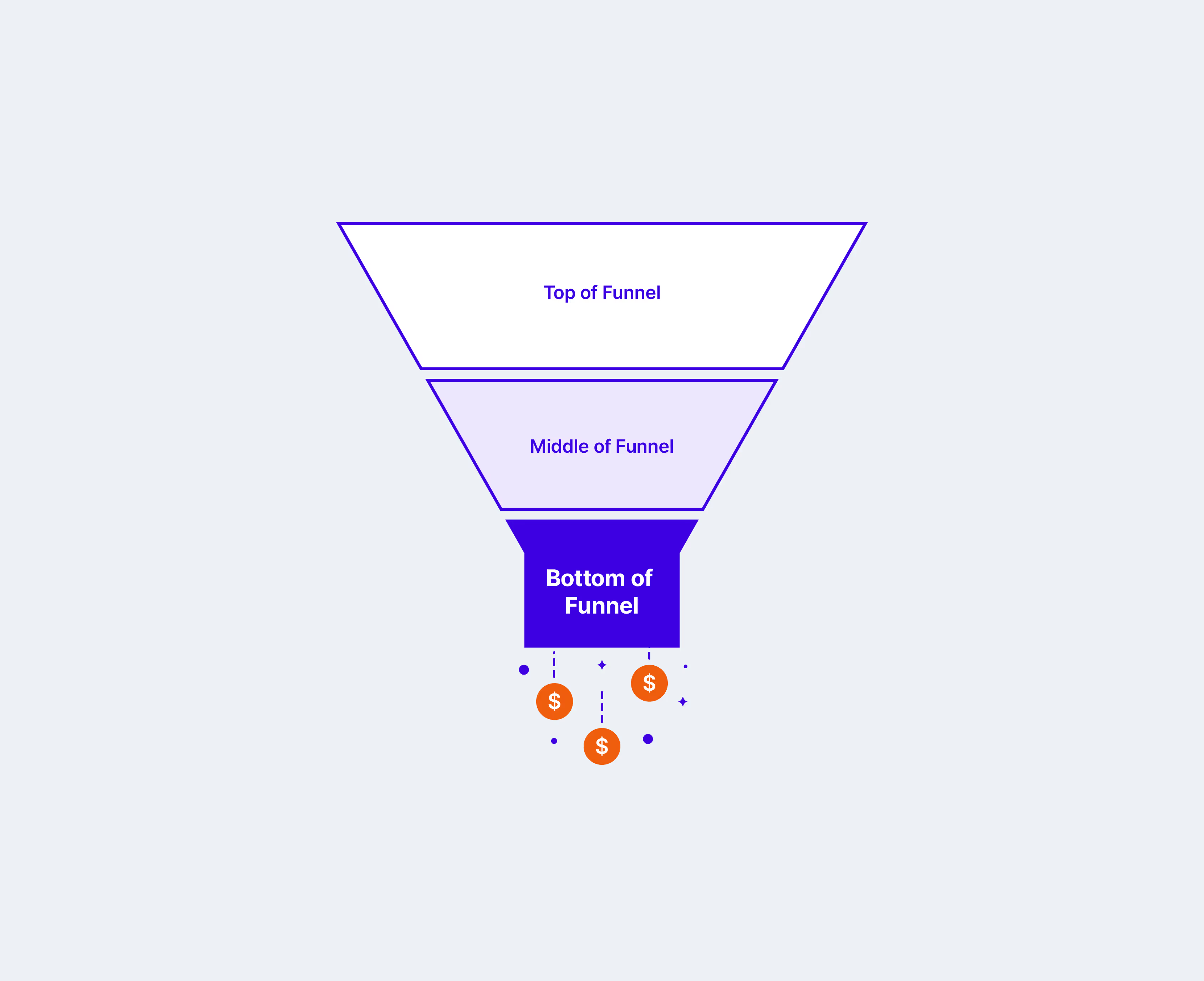The bottom of the funnel (BoFu) is where a lot of conversions happen and where revenue is generated. At my first company, our BoFu pages and keywords accounted for something like 75% of the conversions and call-to-action (CTA) clicks across a very large website.
The BoFu is the final stage of the marketing process. At this stage, the searcher or potential buyer knows that they want a specific type of product or service, is likely somewhat familiar with the different products available, and is ready to take action.
BoFu content should help the searcher or reader make a more educated decision and ideally prompt them to consider your product as their final decision.
As a quick example, a BoFu keyword might be “best CRM software for startups.”
This article will focus on BoFu best practices. I’ll walk you through a few different types of BoFu pages and keyword types, and I’ll highlight a few common SEO mistakes that I see companies make.
Types of BoFu Keywords
There are many different types of BoFukeywords, and they often work better together than in a silo. Here are a few of my favorite types of BoFu keywords.
The Bests
You’ve probably searched for “best [type of product]” — for instance, “best air purifier” — before. And you may have gotten a little more specific in some searches, with “best [type of product] for [more specific use case]” — for example, “best air purifier for allergies.”
These are very popular types of keywords for searchers.
Here are a couple more quick examples.
Broad: “best CRM software.”
More specific: “best CRM software for small businesses,” “best CRM software for hotels,” and “best CRM software for nonprofits.”
To target these keywords, you’ll often want to create a listicle or roundup, given that the searcher is likely looking to compare multiple options. For example, for the keyword “best CRM software for hotels,” the top-ranking search result is a roundup of the best options:

Hotel Tech Report is a comparison and advice website for hotel software buyers. This page is a collection of different CRM software designed to meet the needs of hotels:
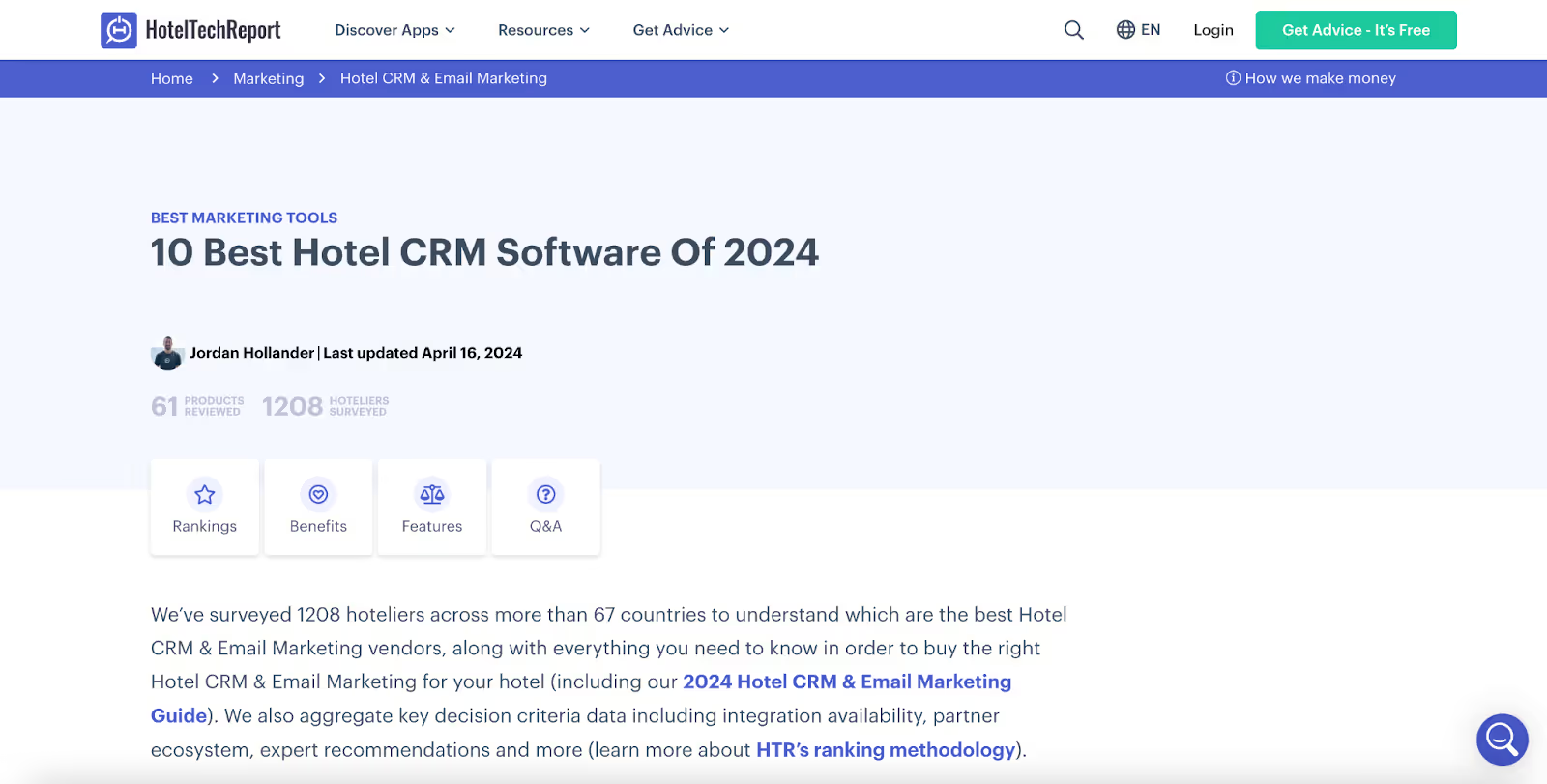
Their page has in-depth reviews of 10 different CRM software solutions.
While Hotel Tech Report is an independent third party, you could certainly target this keyword if you were a CRM company looking to sell to hotel buyers.
For example, for the keyword “best CRM software for small businesses,” Monday.com delivers a roundup of CRM software on their website:

Unsurprisingly, Monday positions its own software as the first option above a number of competitive products:

Searchers are likely smart enough to know that Monday is deliberately ranking itself as the top option. But this article is helpful because it also explores many other options in equal depth. Monday is also clear as to where and for whom their product is most helpful and where competitive products might actually be a better choice for a specific type of buyer.
It might feel uncomfortable to plug competitive products alongside your own, but know that if you don’t, you likely aren’t giving searchers what they want (they want to compare multiple options — hence the word “best” or “top”), and as a result, you probably won’t rank.
The Alternatives
“Alternatives” keywords are some of my favorites, as these keywords tend to be fairly high intent and are often very easy, or low difficulty, compared to “best” keywords.
You can create “[my product] alternatives” pages for your own product, and you can create “[my competitor’s product] alternatives” pages to serve people looking for options to a competitor’s product.
Earlier in my career, we competed against companies like Datadog, and one of our best-performing keywords was “Datadog alternatives.”
While this keyword has a fairly low search volume, it has a very low difficulty score, so you could rank for this keyword fairly quickly:

Today, one of the top-ranking search results for the keyword “Datadog alternatives” is a page on a website for a company called SigNoz, which is an open-source alternative to Datadog:

Similar to the “best” page from Monday.com highlighted above, on this “alternatives” page, SigNoz positions itself as the top option or alternative to Datadog:

I like how SigNoz reiterates that they are a great alternative for someone specifically looking for an open-source option. And I like how SigNoz positions eight other options alongside their own for searchers.
With an “alternatives” keyword, a searcher is likely looking to compare multiple options, and you’ll need to deliver a roundup of options to consider. A good approach here might be to label each alternative as “best for [specific thing that the alternative would be best for]” (for instance, “best for small businesses”).
Another good example is “Zendesk alternatives,” as it’s a relatively easy keyword, but it’s still getting good search volume:

For this keyword, Kustomer has the top-ranking page: a roundup of 20 of the top options to consider if you’re looking for an alternative to Zendesk:

And again, they position themselves as the top option above 19 other options to consider:
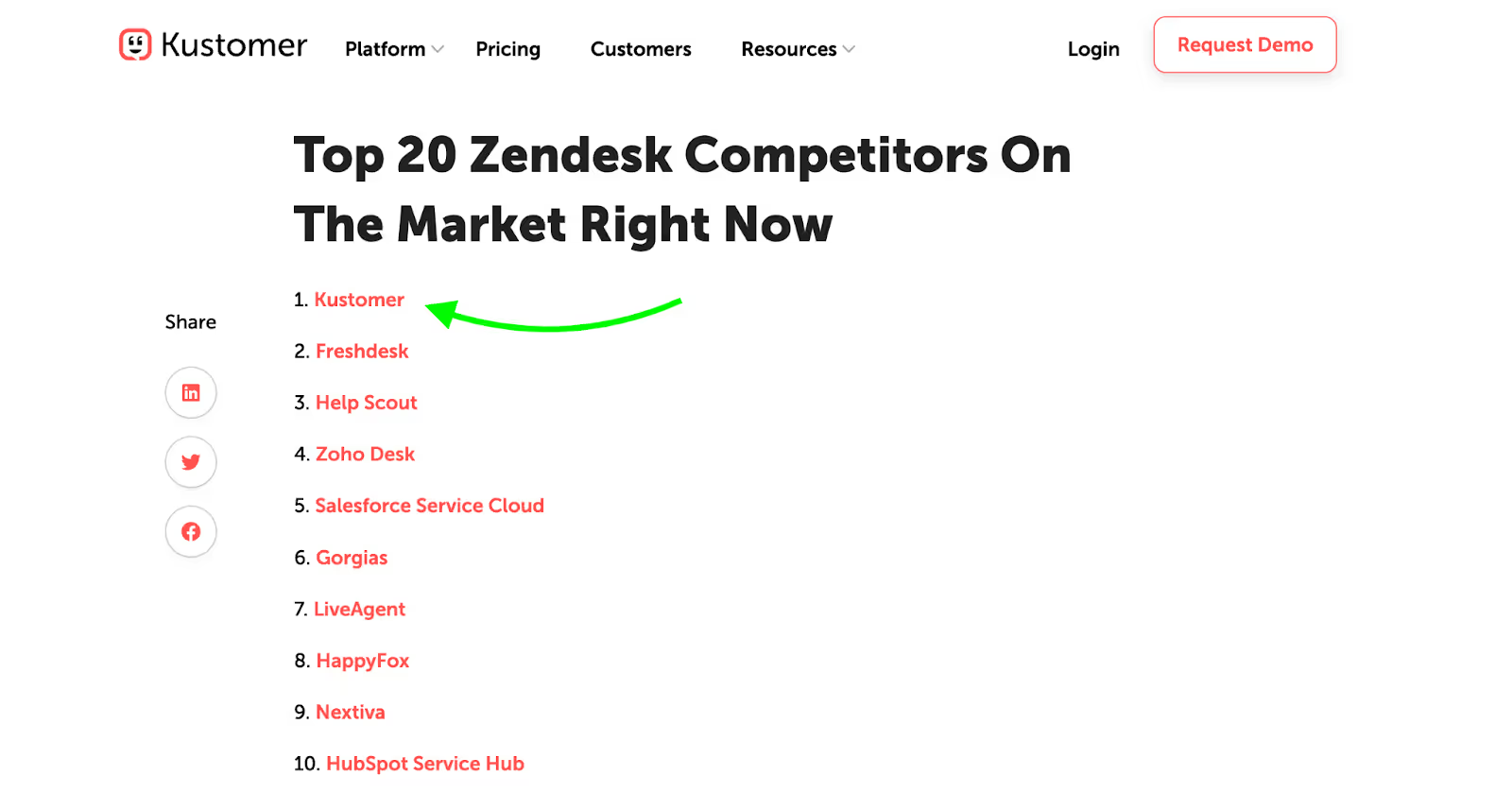
Notice that Kustomer is also trying to hit the longer-tail keyword “Zendesk competitors.” If you are going for an “alternatives” keyword, Google is likely smart enough to figure out that your page should serve the variant keyword related to “competitors,” but you could optimize for it directly within the header elements of your page if you’d like.
Product vs. Product
Don’t get me started on the benefits of “[product A] versus [product B]” keywords. Like “alternatives” keywords, “product versus product” keywords are high intent and often have very low competition, when compared with “best” keywords.
For example, the keyword “Salesforce vs. HubSpot” is getting good search volume and is only moderately difficult:

The top search result for this keyword is actually from HubSpot:

This is a smart move by HubSpot. They’ve created a comparison page on their own website highlighting the difference between themselves and Salesforce, and it is ranking really well:

You can absolutely create “product versus product” pages for keywords where your product is one of the options for comparison. And you’ll likely rank well fairly quickly.
That being said, you can, of course, target these keywords if your product is competitive with the two popular, competitive products being compared. This is a popular strategy for startups and newer companies that may have just started competing within a product space, so searchers don’t yet know about their brand.
For example, below HubSpot’s comparison page, we see that Monday.com is ranking quite well with a blog post comparing HubSpot and Salesforce:

Given that Monday.com’s CRM product competes against HubSpot and Salesforce, the company is trying to intercept traffic and re-route it to their own product.
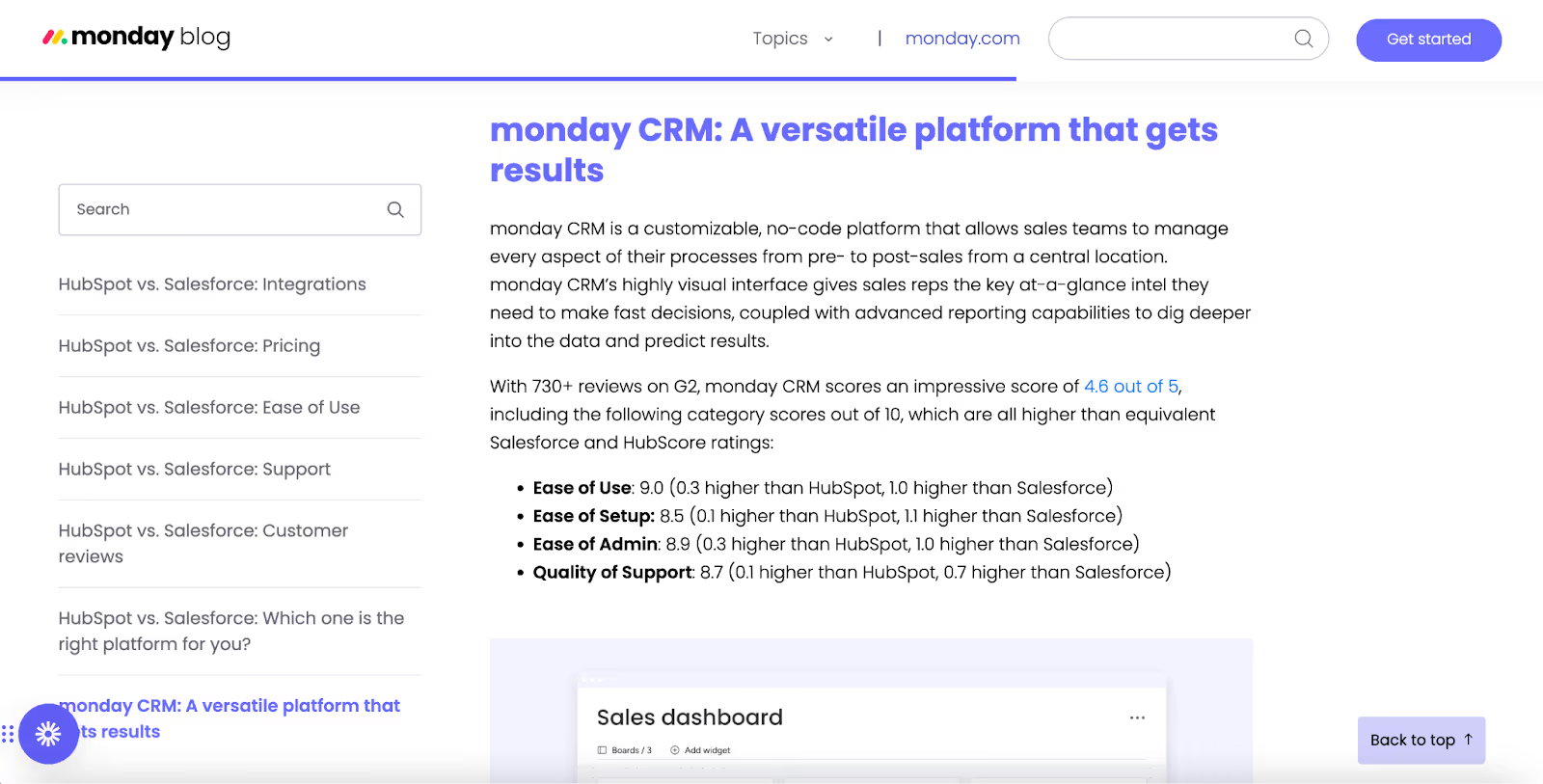
Monday does a great job of comparing HubSpot and Salesforce in-depth, and they are providing a high-quality experience for searchers looking to compare those two products. But within this article, they also have a section that highlights their own CRM product as an alternative to those two products.
High-Intent Problem-Focused Keywords
The middle of the funnel (MoFu) is often an underappreciated section of the sales funnel. Here, a searcher might have an issue or problem but not yet know that they need a product or service.
However, some (MoFu) keywords leak into the bottom of the funnel if they are extremely closely related to the core value proposition of your product. In other words, if your product helps a searcher solve their problem directly, that might be a BoFu keyword.
For example, at Positional, we target the keyword “find competitor keywords” with a blog post on our website. For a keyword like “find competitor keywords,” it’s unclear whether the searcher is looking to learn more about how to find a competitor’s keywords, or if they’re looking for a tool to help them do that right now.
We target this keyword with a blog page that explains the process of approaching competitor keyword research, but we also mention six different toolsets that a content marketer could use to identify these keywords:

Within our article, we highlight our own toolset alongside five other options to consider:

While this “how to” keyword might be a MoFu keyword for some, it’s a BoFu keyword for us, since our product solves this exact problem.
We approach this keyword with a hybrid page that’s helpful both for someone who’s just looking to learn more about the process and for someone who’s looking for a solution to this problem right now.
Branded Keywords (Reviews, Pricing, Case Studies, Webinars, and So On)
Towards the end of the funnel, a searcher might already be familiar with your product or service and might just be looking to gather more information about it. You’ll want to make it easy for this searcher to find supplementary information about your product, so you can make an effective case for purchasing it.
There are a few keyword modifiers that we could explore here: reviews, pricing, case studies, and webinars.
Reviews
By the time someone is looking for reviews about your product, they’re likely pretty far into the sales funnel. Of course, there might be reviews about your product on other websites, either review platforms or other content marketers looking to target these keywords for themselves. But you can certainly go after them, too.
For example, the keyword “HubSpot reviews” is fairly popular:

For the keyword “HubSpot reviews.” HubSpot ranks in both the first and second spots with pages dedicated to highlighting different reviews about their product:

It will likely be very easy to rank for reviews-related keywords regarding your own product. And you’ll likely want to control this real estate and point searchers to your platform, where they can read reviews that you’ve highlighted as being especially relevant.
Pricing
Buyers are, of course, going to look for pricing information about your product. Make it easy for them to find this information on your own website.
For example, the keyword “HubSpot pricing” is a popular one:

And HubSpot controls the first three search results with pricing pages for the products that they offer.
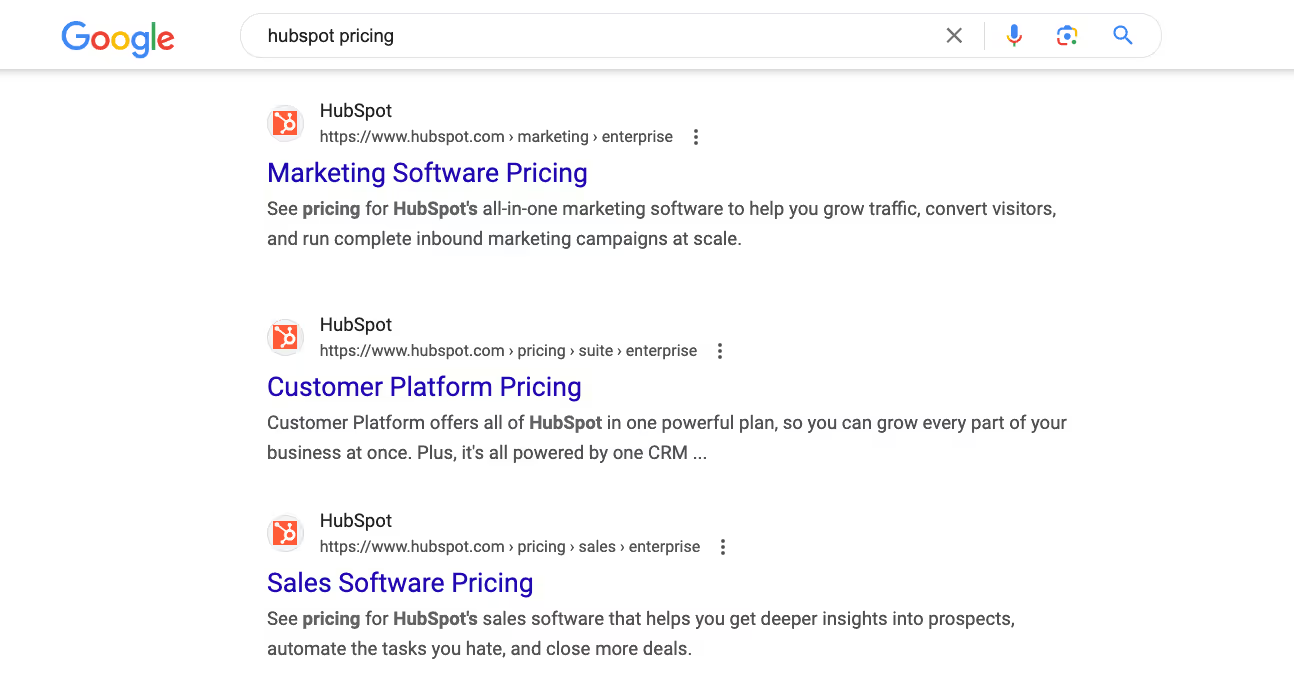
Case Studies
Case studies are very important in the sales process. They arm potential customers with the information they need to build a case for a purchase and get buy-in from their organization. They might also be important from an SEO standpoint.
For example, the keyword “HubSpot case studies” is a popular one and has relatively low competition:

And again, HubSpot is ranking in the top search results with a directory of all the different types of case studies they have available:

Webinars
And last but not least, webinars: If you’re already creating webinars, make them easy to find in search engines.
The keyword “HubSpot webinars” gets a meaningful amount of search interest and has fairly low competition:

As you’d expect by now, HubSpot owns the top few search results for this keyword:

Mistakes Companies Make with BoFu Content
There are a few gotchas that you should keep in mind from an SEO perspective.
Avoid Using Product Pages When You Need a Roundup
While it might be tempting to try to rank for a keyword like “best CRM software” with a product page for your specific product, ranking well with a product page is unlikely.
A search modifier like “best,” “top,” or “alternatives” generally suggests that the searcher is looking to compare multiple options, not to consider only your option.
You need to build the right type of page, either a product page, a blog or content page, or something else.
If you’re ever confused as to whether you should create a product page or a content page for a given keyword, the easiest thing to do is to Google that keyword, and if you see, for example, that nine out of the top ten results are content pages, than you’ll want to create a content page for the given keyword.
When you see the word “best” or “top,” you generally want to create a content page highlighting the best options to consider.
Avoid Over-Promotion of Your Own Product, for Certain Keywords
As we saw in some of the examples above, for “best” or “alternatives” keywords, you’ll often need to present your product alongside a host of other options for the searcher to consider.
You should be careful not to make your roundup or listicle overly promotional about your product. For example, I was talking to a customer the other day, and 85% of their “best” page was about their product, and they hardly ever even mentioned the other options they were supposed to be highlighting.
If you’re targeting a “best” or “alternatives” keyword, and you’re mentioning your own product, ensure that you are mentioning it fairly and organically.
Avoid Reusing Identical Content Across Multiple Pages
I’ve seen this one a few times. If you create multiple “best, “product vs. product,” or “alternatives” pages, be careful not to copy and paste the same content over and over again between pages.
For example, if you had one page targeting “Salesforce vs. HubSpot” and another page targeting “Salesforce vs. Zoho,” you wouldn’t want to copy and paste that Salesforce section from one page to the next.
I realize that there can be some repetitiveness here. And if I was working with freelance content writers, I would actually probably assign these two pages to two different writers. But if a single content writer is writing both pages, make sure to remind them not to copy large amounts of text from one page directly to the next. This can lead to duplicate content issues and keyword cannibalization, or just generally confuse Google as to which keywords each page should be ranking for.
Don’t Do Only BoFu Content
A lot of companies want to do only BoFu content to serve BoFu keywords. While these keywords might be where most conversions will come from, the MoFu and ToFu (top of the funnel) are also important.
MoFu keywords can be incredibly valuable, especially if your product is closely related to the problem that searchers are experiencing or trying to solve for. For example, when I was in the Kubernetes space, we created a large number of tutorials and guides explaining common issues that folks were having with their Kubernetes clusters. We answered those questions, and then presented our product as a way to monitor for those issues in the future.
Moreover, ToFu and MoFu content can drive conversions. But you might find that the sales process is a little more nuanced. With a ToFu keyword like “what is a CRM,” it would probably be very hard to convert a customer today, but that searcher might be someone whose email address you’d like to get (for instance, with a whitepaper download) or someone you’d like to add to your email newsletter mailing list.
It’s also worth mentioning that MoFu and ToFu content is extremely important from a topical authority and domain authority perspective. You want to build topical authority — in other words, you want to show Google that your website is a great source of information about a given topic. And you want to build domain authority — in other words, you want to accumulate backlinks back to your website. Often, ToFu and MoFu content will accumulate a lot more backlinks than BoFu content. By building topical and domain authority, you’ll ultimately help BoFu content rank better.
SEO Is a Fantastic Channel but Not the Only Channel
One of the key learnings I’ve had over the past few years is that SEO can’t exist in a vacuum. Even if you rank first for a high-intent BoFu keyword, if no one has ever heard of your product or company before, those pages are less likely to convert.
Brand is so important when it comes to actually converting traffic into dollars, and you’ll want to think critically about all of the other brand and marketing initiatives that exist outside of SEO. The companies that stand the most to benefit from BoFu keywords are often the companies that need them the least.
Final Thoughts
The article you just read is likely a MoFu content for our website. This page is meant for someone who’s looking to learn more about BoFu keywords, and they might need a toolset to help them find those keywords eventually.
Know that every website should have a BoFu content and SEO strategy. Start by trying to identify the different types of keywords with high search volume in your industry. Consider “best,” “alternatives,” “product vs, product,” and “how to” keywords with high intent that align directly with your core value proposition. And for potential buyers that are deep in the sales process, create content such as case studies, webinars, reviews, and pricing information.
As a final word of caution, when you’re building webpages to serve BoFu keywords, make sure to build the right type of page. You almost always want to build a page — whether it’s a product page, a blog post, or something else — that aligns with what’s ranking well today and with the search intent.
